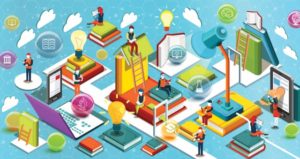
The Illusion of Good Class Discussions and What to Do About It
Providing a high-quality education where students have the opportunity to take part in active learning is one of the most important things we can do


Providing a high-quality education where students have the opportunity to take part in active learning is one of the most important things we can do

When I began designing my course activities, I needed a model that would include all modalities of the learning processes. As my blueprint, I chose

In-class activities can be a great way to foster student engagement in the classroom. Depending on the activity, the results can vary greatly. Sometimes they

Because I teach mixed demographic courses, I often look out at a sea of distracted and unmotivated faces. Motivation is a large part of learning (Pintrich and deGroot, 2003). So, I use active learning activities, such as think-pair-share, to not only motivate students (Marbach-Ad et al., 2001), but also to enhance student learning (Bonwell and Eison, 1919; Freeman et al., 2014). If I’m being honest, active learning also has the added perk of distracting students from the monotony of my voice. Yet, in the past few years, I have begun to wonder if I have taken it too far? Am I simply using active learning as a way of keeping bored students active?

Looking to incorporate some learner-centered teaching principles into your courses but aren’t sure where to begin? Here are 10 activities for building student engagement and getting students more actively involved in their learning.

As a professor of cognitive psychology, I teach about memory, especially about when and why our memories often fail us. Students are excited to apply this material to their everyday lives.

Those who teach in the health disciplines expect their students to retain and apply every iota of learned material. However, many students come to us having achieved academic success by memorizing the content, regurgitating that information onto an exam, and promptly forgetting a good portion of it. In health, as well as other disciplines where new material builds upon the material from the previous semesters, it is critical for students to retain what they learn throughout their coursework and as they begin their careers as a nurse, engineer, elementary teacher, etc.

An analysis of more than 2,000 college classes in science, technology, engineering and math has imparted a lesson that might resonate with many students who sat through them: Enough with the lectures, already.

A 2015 survey of Faculty Focus readers found that the number one barrier preventing faculty from implementing the flipped classroom model and other active learning experiences into their courses is TIME. Faculty reported they don’t have time to plan extra learner-centered activities, due to increasing responsibilities, and they don’t have time to implement the activities in class because there’s too much content to cover.
If you feel this way, you’re not alone. But, you can still create engaging learning experiences for students. And you can do it in 10 minutes (or less).

I keep worrying that we’re missing the boat with active learning. Here’s why. First, active learning isn’t about activity for the sake of activity. I fear we’ve gotten too fixated on the activity and aren’t as focused as we should be on the learning. We’re still obsessed with collecting teaching techniques—all those strategies, gimmicks, approaches, and things we can do to get students engaged. But what kind of engagement does the activity promote? Does it pique student interest, make them think, result in learning, and cultivate a desire to know more? Or is it more about keeping basically bored students busy?
Get exclusive access to programs, reports, podcast episodes, articles, and more!